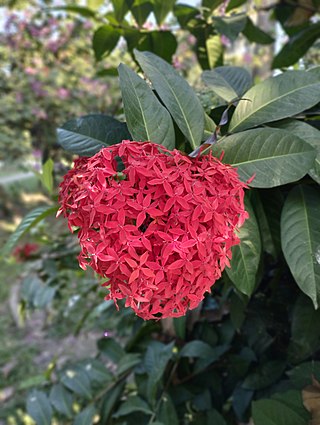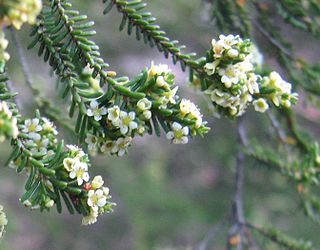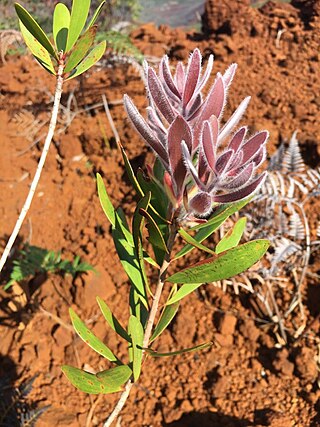
Abarema is a neotropical genus in the family Fabaceae. It is native to Brazil, Cuba, and Venezuela. Most of the species can be found in the Amazon Basin and the Guyana Highlands. They have a deep-green fernlike foliage, with bipinnately compound leaves.

Cullen is a genus of legumes native to tropical, subtropical and arid regions of Africa, Asia and Australia. Despite the origin implied in the name of the constituent species Cullen americanum, legumes of this genus are not native to the Americas.

Syzygium is a genus of flowering plants that belongs to the myrtle family, Myrtaceae. The genus comprises about 1200 species, and has a native range that extends from Africa and Madagascar through southern Asia east through the Pacific. Its highest levels of diversity occur from Malaysia to northeastern Australia, where many species are very poorly known and many more have not been described taxonomically. One indication of this diversity is in leaf size, ranging from as little as a half inch to as great as 4 ft 11 inches by sixteen inches in Syzygium acre of New Caledonia.

Ixora is a genus of flowering plants in the family Rubiaceae. It is the only genus in the tribe Ixoreae. It consists of tropical evergreen trees and shrubs and holds around 544 species. Though native to the tropical and subtropical areas throughout the world, its centre of diversity is in Tropical Asia. Ixora also grows commonly in subtropical climates in the United States, such as Florida where it is commonly known as West Indian jasmine.

Sir John William Dawson (1820–1899) was a Canadian geologist and university administrator.

Prototaxites is an extinct genus of terrestrial fossil fungi dating from the Late Silurian until the Late Devonian periods. Prototaxites formed large trunk-like structures up to 1 metre (3 ft) wide, reaching 8 metres (26 ft) in length, made up of interwoven tubes around 50 micrometres (0.0020 in) in diameter, making it by far the largest land-dwelling organism of its time.

Micromyrtus is a genus of flowering plants in the family Myrtaceae and is endemic to Australia. Plants in the genus Micromyrtus are shrubs with simple leaves arranged in opposite pairs, and white, pink or yellow flowers arranged in upper leaf axils, the flowers with five sepals five petals and five or ten stamens.

Opuntia galapageia is a species of cactus. It is endemic to the Galápagos Islands, part of Ecuador. Forms occurring on different islands have been treated as separate species and subtaxa of these species. Opuntia echios, Opuntia helleri, Opuntia insularis, Opuntia megasperma, Opuntia myriacantha and Opuntia saxicola are now sunk within O. galapageia.

Pseuduvaria is a genus of the plant family Annonaceae and tribe Miliuseae: with a native range is Tropical Asia.

Xanthostemon is a genus of plants in the myrtle family Myrtaceae, first described in 1857 by the German–born Australian botanist Ferdinand von Mueller. The genus is distributed across Malesia, Papuasia and northern Australia. The genera Pleurocalyptus and Purpureostemon from New Caledonia are morphologically close to Xanthostemon.

The Antarctic Floristic Kingdom, also the Holantarctic Kingdom, is a floristic kingdom that includes most areas of the world south of 40°S latitude. It was first identified by botanist Ronald Good, and later by Armen Takhtajan. The Antarctic Floristic Kingdom is a classification in phytogeography, different from the Antarctic realm classification in biogeography, and from Antarctic flora genera/species classifications in botany.

Astelia is a genus of flowering plants in the recently named family Asteliaceae. They are rhizomatous tufted perennials native to various islands in the Pacific, Indian, and South Atlantic Oceans, as well as to Australia and to the southernmost tip of South America. A significant number of the known species are endemic to New Zealand. The species generally grow in forests, swamps and amongst low alpine vegetation; occasionally they are epiphytic.

Sannantha is a genus of flowering plants in the family Myrtaceae that are native to Australia and New Caledonia. Plants in the genus Sannantha are shrubs or trees with leaves arranged in opposite pairs, flowers usually arranged in small groups, the peduncles often 1.5–2 times as long as the pedicels and with seven to fourteen stamens. The fruit is a thin-walled capsule containing flattened, D-shaped seeds. Some species of Sannantha were previously included in the genus Babingtonia.

Melaleuca pancheri is a shrub or small tree in the myrtle family, Myrtaceae and is endemic to the south of Grande Terre, the main island of New Caledonia. It is one of only a few members of its genus to occur outside Australia and was formerly known as Callistemon pancheri Brongn. & Gris.

Dracophyllum longifolium, commonly called inaka, is an upright shrub or small tree in the family Ericaceae that is endemic to New Zealand.

Pleurocalyptus is a group of shrubs and small trees in the family Myrtaceae, first described as a genus in 1868. The entire genus is endemic to New Caledonia. It is closely related to Xanthostemon.
Metrosideros elegans is a species of plant endemic to New Caledonia in the family Myrtaceae. The tree has yellow flowers and grows most commonly between about 300 and 1,500 metres altitude in forest or shrubland. It is sometimes epiphyte at first.
John Wyndham Dawson was a New Zealand botanist.
Gingidia is a genus of flowering plants belonging to the family Apiaceae.

Scandia is a genus of flowering plants belonging to the family Apiaceae. It is also in tribe Aciphylleae, with plants, Gingidia Dawson and Lignocarpa Dawson, with all three genera being native to New Zealand. They are scrambling shrubs with white flowers.
















